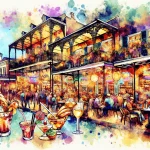New Orleans boasts a storied reputation as the birthplace of the cocktail, where the art of mixology has flourished over two centuries. From the iconic Sazerac to the lively Hurricane, the city’s cocktail culture is an intricately woven tapestry of history, innovation, and a unique blend of cultural influences.
In This Article
TL;DR
- The Sazerac, often regarded as America’s first cocktail, originated in New Orleans during the 1830s.
- Influential figures like Antoine Peychaud and Henry C. Ramos played pivotal roles in shaping the city’s cocktail scene.
- New Orleans‘ cocktail culture has evolved over time, adapting to changing trends while preserving its rich heritage.
The Birth of the Cocktail in New Orleans
The origins of the cocktail in New Orleans can be traced back to the early 19th century, when the city’s unique cultural melting pot gave rise to a new era of mixed drinks. As a bustling port city, New Orleans attracted people from all walks of life, each bringing their own traditions and flavors.
It was in this vibrant atmosphere that the Sazerac, often hailed as America’s first cocktail, emerged. The drink’s origins date back to the 1830s, when Antoine Amedie Peychaud, a Creole apothecary, began serving a concoction of Sazerac-de-Forge brandy, bitters, and absinthe in his New Orleans shop.
Influential Ingredients and Techniques
New Orleans’ cocktail culture was shaped by the introduction of key ingredients like absinthe, a potent anise-flavored spirit once banned in the United States, and rum, which arrived through thriving Caribbean trade routes. Local innovations, such as the “Sazerac” technique of rinsing a glass with absinthe and discarding the excess, added a distinctive flair.
The Role of New Orleans in Popularizing Cocktails
New Orleans’ strategic location as a major port city played a crucial role in spreading cocktail culture throughout America. As sailors and travelers passed through, they encountered the vibrant social scene and allure of New Orleans’ cocktails, carrying these experiences and flavors back to their hometowns.
Key Figures in the New Orleans Cocktail Scene
Legendary Bartenders and Mixologists
The evolution of New Orleans’ cocktail scene is inextricably linked to legendary bartenders and mixologists who pushed mixology boundaries.
One such figure is Antoine Peychaud, whose eponymous bitters became an essential ingredient in the Sazerac and countless other cocktails. Another is Henry C. Ramos, who created the iconic Ramos Gin Fizz in 1888, a frothy concoction of gin, lime juice, egg white, and cream that became a sensation.
Impact of Immigrant Communities
New Orleans’ cocktail culture has been shaped by diverse immigrant communities that have called the city home over centuries. From French and Spanish influences that gave rise to the Sazerac to Caribbean flavors that inspired the Hurricane, the city’s cocktails reflect an intricately woven tapestry of cultural influences.
Iconic Cocktails of New Orleans
The Sazerac
The Sazerac, often referred to as America’s first cocktail, is a true icon of New Orleans’ cocktail heritage. This potent blend of rye whiskey, Peychaud’s bitters, and absinthe (or a substitute like Herbsaint) has evolved over time but remains rooted in the city’s history.
The Hurricane and Other Classics
While the Sazerac is steeped in tradition, New Orleans has also given birth to modern classics like the Hurricane, a rum-based drink created at Pat O’Brien’s in the 1940s and now a beloved symbol of the city’s revelry.
Other iconic cocktails include the Vieux Carré, a sophisticated blend of rye whiskey, Cognac, and various bitters, and the Ramos Gin Fizz, a labor-intensive concoction requiring vigorous shaking for its signature frothy texture.
Evolution of Cocktail Trends in New Orleans
Prohibition and Its Aftermath
Like many cities across America, New Orleans’ cocktail scene was profoundly impacted by Prohibition, which lasted from 1920 to 1933. During this period, many bars and saloons closed, and the city’s cocktail culture went underground.
However, New Orleans’ resilient spirit prevailed, and bartenders found creative ways to keep the tradition alive, often serving cocktails under the guise of “tonics” or “medicinal elixirs.”
Modern Cocktail Renaissance
In recent decades, New Orleans has experienced a resurgence of interest in classic cocktails, with contemporary bartenders paying homage to the city’s rich mixology heritage while innovating with new techniques and ingredients.
Establishments like the Sazerac Bar at the Roosevelt Hotel and the Carousel Bar at the Monteleone Hotel have become iconic destinations, offering meticulously crafted drinks that celebrate the city’s history while pushing mixology boundaries.
Experiencing New Orleans’ Cocktail Culture Today
Best Bars and Historical Venues
To truly immerse yourself in New Orleans’ cocktail culture, visit iconic bars and historical venues.
The Sazerac Bar, located in the Roosevelt Hotel, is a prime destination for experiencing the city’s cocktail heritage, where you can sip a perfectly crafted Sazerac amidst ornate decor and rich history.
Another must-visit spot is the Napoleon House, a 200-year-old building that once served as a residence for the exiled French emperor’s family. Today, it’s a beloved bar known for its Pimm’s Cup, a refreshing gin-based cocktail perfect for the city’s sultry climate.
Tips for Cocktail Enthusiasts
To fully appreciate New Orleans’ cocktail scene, approach it with an open mind and willingness to explore. Don’t hesitate to converse with bartenders and ask for recommendations – their expertise and passion are unparalleled.
When sampling cocktails, savor each sip and appreciate the intricate flavors and techniques. Remember, cocktail culture in New Orleans encompasses more than just drinks – it’s an experience that captures the city’s rich history, vibrant atmosphere, and warm hospitality.
The Influence of New Orleans on Global Cocktail Culture
Exporting New Orleans Mixology
New Orleans’ influence on global cocktail culture is undeniable. The city’s mixology techniques and iconic cocktails have been adopted and adapted worldwide, inspiring bartenders and enthusiasts alike.
The Sazerac, for example, has become a staple in cocktail bars globally, with each establishment putting its own spin on the classic recipe. Similarly, the Hurricane has found its way onto menus across the globe, offering a taste of New Orleans’ revelry.
New Orleans Cocktail Festivals
To celebrate and promote the city’s cocktail heritage, New Orleans hosts several annual festivals and events that draw mixologists and enthusiasts worldwide.
One of the most renowned is Tales of the Cocktail, a multi-day festival featuring seminars, tastings, and competitions centered around mixology. Held annually in July, this event attracts thousands and has become a must-attend gathering for anyone passionate about cocktails.
Another notable event is the New Orleans Bourbon Festival, which takes place each March and celebrates the city’s love affair with bourbon and whiskey. Attendees can participate in tastings, seminars, and even a bourbon-themed parade through the French Quarter.
By hosting these festivals and events, New Orleans showcases its rich cocktail culture and solidifies its position as a global leader in mixology.
The Influence of New Orleans on Global Cocktail Culture
New Orleans’ influence on global cocktail culture extends far beyond its iconic drinks and festivals. The city’s mixology techniques and innovative approaches have inspired bartenders worldwide, shaping how cocktails are crafted and enjoyed.
From the meticulous attention to detail in the preparation of a Ramos Gin Fizz to the bold flavors of the Vieux Carré, New Orleans’ cocktail culture has left an indelible mark on the global mixology scene. As bartenders worldwide continue to explore and experiment, the spirit of New Orleans’ cocktail heritage remains a guiding force, reminding us of the rich history and cultural influences that have shaped the art of mixology.
Whether sipping a Sazerac in a dimly lit bar or enjoying a Hurricane on the vibrant streets of the French Quarter, the influence of New Orleans’ cocktail culture is undeniable. It’s a legacy that continues to inspire and captivate, inviting us to raise a glass and toast to the city that gave birth to the cocktail as we know it today.






